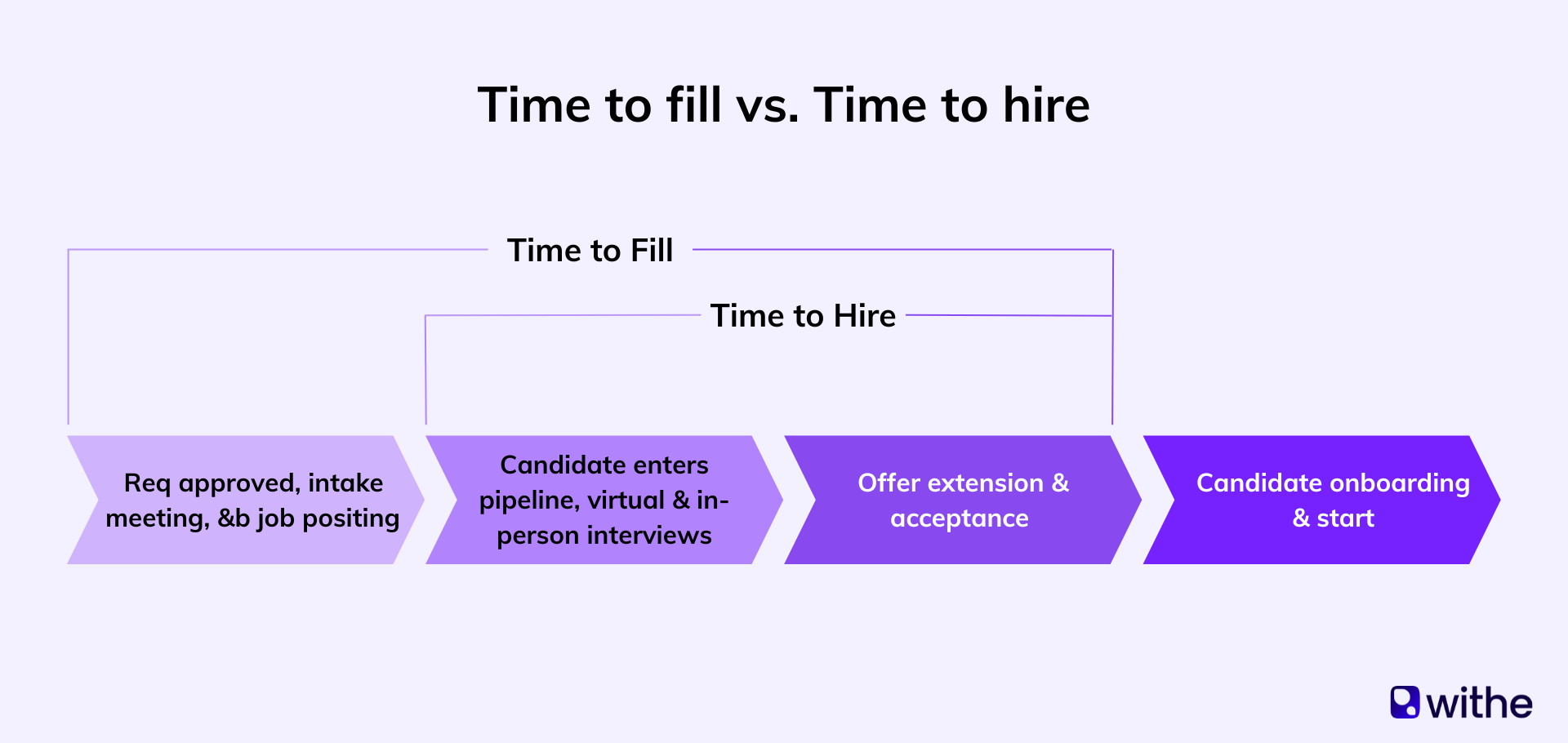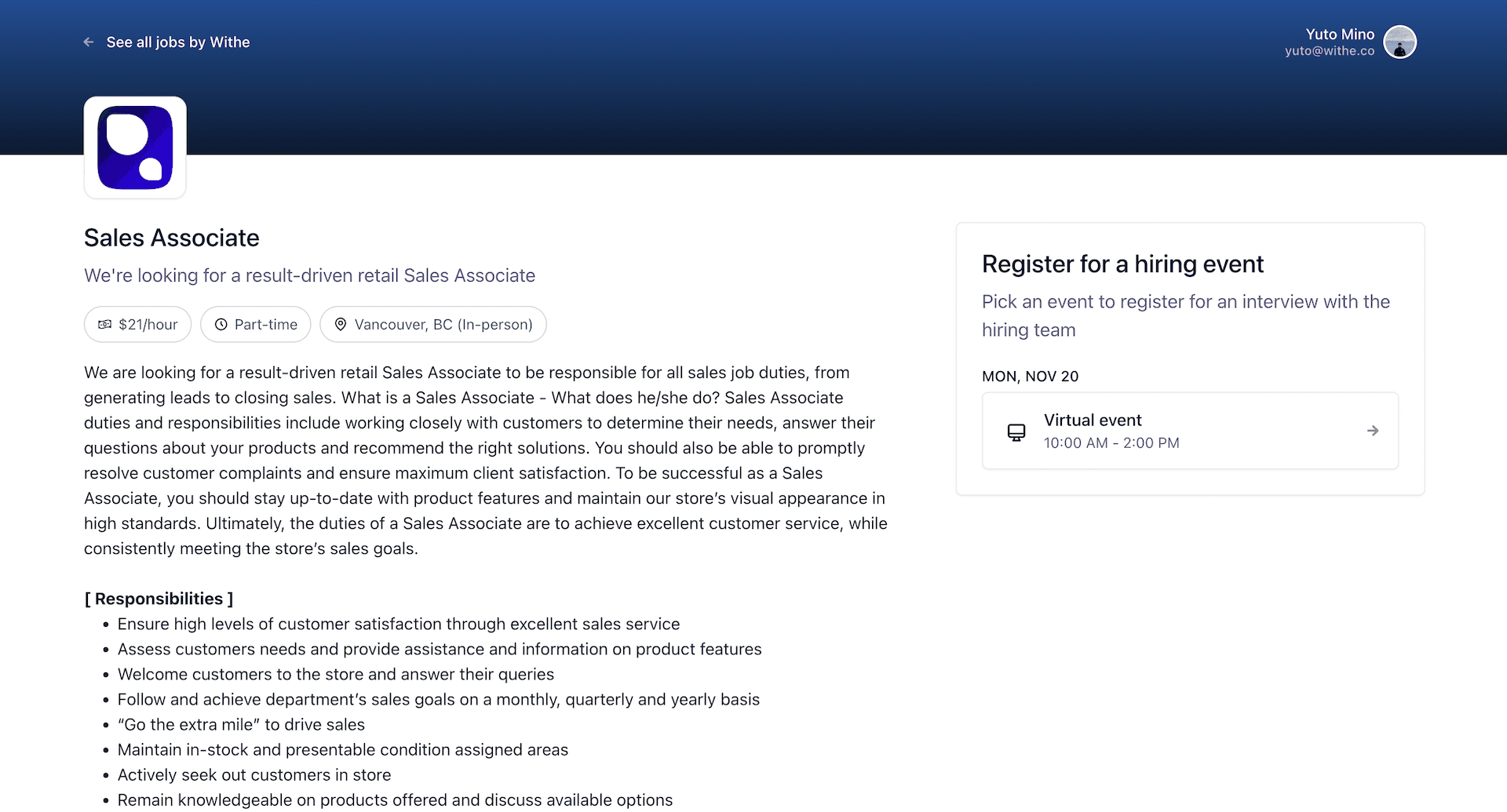Leverage Withe's hiring event platform
Streamline your seasonal and high-volume hiring process and hit your hiring targets.
Recruiters can all agree that hiring is an inherently human process, but that doesn’t mean it can’t also be performance and data driven. To be as effective as possible, today’s recruiting teams need to be agile and efficient, without compromising the candidate experience. It’s a tricky balance to strike, but one way to succeed is by tracking relevant metrics and using those insights to identify potential areas of improvement in your hiring process.
One such metric is time to hire. Alongside other key recruitment metrics like time to fill, no-show rates, and offer acceptance rate, understanding time to hire can help you get a clear picture of how efficient and effective your hiring process is. To help you make the most of this metric — and perform well against it — we’re sharing a definition as well as 10 best practices for lowering your time to hire.
Leverage Withe's hiring event platform
Streamline your seasonal and high-volume hiring process and hit your hiring targets.
What is time to hire and why does it matter?
Time to hire is a metric that measures the amount of time between a candidate applying for a role and accepting an offer. In other words, it measures the time that a successful candidate spends in the recruiting process from end to end. Recruiting teams can then use this metric to identify the average time to hire for all roles, roles in specific teams, and even a specific role. With this insight, they can then measure their performance against industry benchmarks and set goals for improvement.
Time to hire is also a useful metric in that it helps recruiters understand which roles or teams are harder to hire for, and where they may need to invest more marketing or headhunting budget to help speed up the hiring process.
Today’s best candidates spend an average 10 days on the market before they get another job. As such, it’s important for recruiting teams to be able to move quickly as they move qualified candidates through their hiring journey. This is why looking at your time to hire metric can be so valuable.
Time to hire vs. time to fill
While time to hire and time to fill are sometimes used interchangeably, they are actually different metrics. Instead of looking at specific candidate journeys, time to fill takes a slightly broader perspective, measuring the time between a role being approved for posting, and that role being filled by a successful candidate. In this way, time to fill can be used to get a better sense of how efficient the entire recruiting process is, including the time spent attracting qualified candidates.
In both cases, the goal for recruiting teams is to reduce time to hire and time to fill as much as possible so that they can consistently hire high-quality candidates, quickly.

10 ways to reduce time to hire
What follows are 10 best practices for lowering the time you spend hiring new candidates.
1. Review and optimize your hiring process
If you feel that your time to hire is too long, there may be an opportunity to take a closer look at your processes and determine where things can move faster. Work collaboratively with your recruiters to understand where the roadblocks are, where there’s potential for introducing automation (without compromising the quality of human connections made with candidates), and what help your team needs to move faster.
Once you’ve identified areas of opportunity, prioritize them based on their potential impact and the level of investment required to make them happen. In this exercise, you’ll be able to quickly act on low-hanging fruit and create a roadmap for larger initiatives.
2. Encourage collaboration between hiring managers
Sometimes, even after you’ve optimized parts of the hiring process, there are still roadblocks that come from a lack of collaboration and communication within your team. Look for ways to facilitate quick exchanges of information and introduce central sources of truth for all candidate data so each hiring manager can act quickly when they need to.
3. Write clear job descriptions
One easy way to reduce the time a candidate spends in your hiring process is by ensuring that they are the right candidate for the job. At the end of the day, if they tick all the boxes you have for the role, then it’s much more likely that you’ll be able to move them through the process faster. This is where job descriptions can help.
By writing clear job descriptions with a specific list of requirements, you can increase the likelihood of qualified candidates applying for the role. In addition, spending the time to lay out expectations and professional development opportunities can also proactively answer questions and save time later in the hiring process.
4. Improve your careers page
Similarly, your careers page can be a great way to proactively answer questions that candidates might have during the interview stages of the hiring process. By sharing as much information as possible, transparently, you can save your team from having to go back and forth with candidates. Share details about your corporate culture, career paths, and share stories from some of your employees. Having a consistent and recognizable employer brand can also be useful here.
5. Build an extensive talent pipeline
A talent pipeline is a pool of individuals that your recruiters have identified as being worthy of consideration for future openings. This pipeline is built both organically and intentionally, with candidates being sourced through referrals, open applications, or even through networking events. Having these pre-vetted and engaged candidates on hand can reduce the amount of time needed to shepherd them through the hiring process when a relevant role becomes available, thus reducing time to hire.
At Withe, we’re helping seasonal and volume hiring teams reduce time to hire with our hiring event platform
6. Focus on candidate engagement
Keeping your candidates engaged throughout the process is a great way to ensure that they are eager to respond when you reach out. Be proactive in your communications, and answer their questions before they even ask them. Show them that you’re interested in their feedback throughout the process. Offer the opportunity to speak with existing staff members. Give them ample opportunities to request accommodations at every step of the process.
7. Automate communications where it makes sense
Marketers use automation systems to communicate with and nurture customers — so why not do the same for recruiters? Automating certain communications can help your team provide timely updates, keeping candidates engaged and informed, without having to spend any time writing emails.
While automation is a useful tool here, it’s important to still introduce personalized communications where possible in order to build trusted relationships with candidates. Plus, candidates should have a clear avenue for reaching out to their recruiter in order to ask questions.
8. Meet your candidates where they are
Personalizing the experience for candidates can help improve their experience, but it can also streamline your interactions with them. For instance, you can ask candidates to share their preferred communication channel (e.g. email or SMS). This ensures that you’re reaching out to them through a channel that they are almost guaranteed to be active on, reducing the time it takes for them to get back to you at various stages of the hiring process.
9. Streamline the interview process
A big component in reducing time to hire is being able to create relationships with candidates quickly. The interview process is a great mechanism for this, as real-time conversations allow for recruiters to get a better sense of the candidate and they offer candidates the chance to learn more about the role. However, there’s often a big time gap between when a candidate submits an application and when they meet someone on the employer’s end.
On-demand video interview software and virtual hiring events can enable teams to have these virtual conversations faster. The added benefit? These real conversations are bound to make candidates more likely to accept an offer down the line — especially in high-volume hiring situations.

10. Be flexible in your approach to interviewing
Make it easy for candidates to participate in the interview process, so that you’re not held up with scheduling issues. Offer virtual or hybrid hiring events, and make sure you have options outside of office hours (e.g. in the morning or evenings). As a bonus, if you show your candidates that you are flexible in your approach, they will take that as a positive indicator of how they may be treated on the job.
Related resource: Withe's guide to hosting a successful virtual hiring event
A data-driven approach to recruiting
Reducing time to hire is crucial for today's recruiting teams to remain agile, efficient, and competitive in attracting top talent. By tracking this and other metrics, recruiters can gain valuable insights into their hiring process and identify where they can introduce automation, leverage valuable technologies, and streamline relationship building. At the end of the day, the teams that are equipped with the right insights are the ones that are more likely to be successful in a highly competitive talent landscape.
We’re helping high-volume hiring teams vastly reduce their time to hire. Book a demo to learn how.




